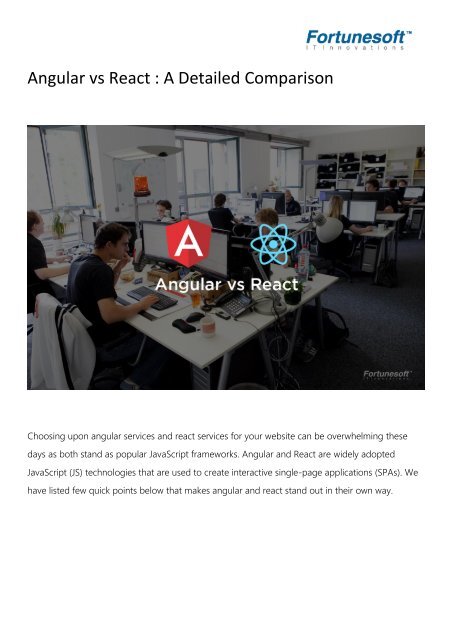Angular Vs React - Comparision between the Two
With so many JavaScript frameworks available for server-side and client-side Angular and React are popular among them. Here are the key differences between the two to help you choose them effectively for your next project.
With so many JavaScript frameworks available for server-side and client-side
Angular and React are popular among them. Here are the key differences between the two to help you choose them effectively for your next project.
You also want an ePaper? Increase the reach of your titles
YUMPU automatically turns print PDFs into web optimized ePapers that Google loves.
<strong>Angular</strong> vs <strong>React</strong> : A Detailed Comparison<br />
Choosing upon angular services and react services for your website can be overwhelming <strong>the</strong>se<br />
days as both stand as popular JavaScript frameworks. <strong>Angular</strong> and <strong>React</strong> are widely adopted<br />
JavaScript (JS) technologies that are used to create interactive single-page applications (SPAs). We<br />
have listed few quick points below that makes angular and react stand out in <strong>the</strong>ir own way.
Technology <strong>Angular</strong> <strong>React</strong><br />
Type<br />
MVC framework written in<br />
JavaScript<br />
JavaScript Library that has<br />
view in MVC, however<br />
requires flux to implement<br />
architecture<br />
Concept/ Process<br />
Works by bringing<br />
JavaScript into HTML with<br />
<strong>the</strong> real DOM client-side<br />
rendering<br />
Works by bringing HTML<br />
into JavaScript with virtual<br />
DOM server-side<br />
rendering<br />
Data Binding <strong>Two</strong>-way data binding One-way data binding<br />
Dependencies<br />
Manages dependencies<br />
automatically<br />
Requires additional tools<br />
to manage dependencies<br />
Best suited<br />
Best for SPA’s that update<br />
single view at a time<br />
Best for SPA’s that update<br />
many views at a time<br />
We have fur<strong>the</strong>r discussed <strong>the</strong>ir individual differences with respect to componentization,<br />
performance, data binding, directives, and templates.
Componentization<br />
<strong>Angular</strong> has a fixed structure and it is based on <strong>the</strong> three layers that are Model, View, and<br />
Controller. The Model is initialized by <strong>the</strong> controller, which is <strong>the</strong>n transformed into HTML to create<br />
View for <strong>the</strong> users.<br />
<strong>React</strong> is created with a different architecture that is distinct from <strong>Angular</strong> but similar to MVC<br />
frameworks. There is no specific structure for <strong>React</strong>. <strong>React</strong> is a vast JavaScript library that updates<br />
<strong>the</strong> views for <strong>the</strong> users, <strong>the</strong> structure lacks model and controller layers, however Facebook<br />
introduced Flux that has better control on <strong>the</strong> application workflow<br />
Performance<br />
The advantage in <strong>Angular</strong>’s performance is <strong>the</strong> feature of two- way data binding whereas <strong>React</strong><br />
utilizes a virtual Document Object Model, which is considered as an advantage of <strong>React</strong> in<br />
comparison with o<strong>the</strong>r frameworks including <strong>Angular</strong>. However, <strong>the</strong> performance of an application<br />
may vary depending on <strong>the</strong> size of <strong>the</strong> application and code optimization.<br />
Data Binding<br />
The Data binding concept is considered as major difference <strong>between</strong> <strong>Angular</strong> and <strong>React</strong>. <strong>Angular</strong><br />
web development uses <strong>Two</strong>-way data binding which means that any change in <strong>the</strong> UI field would<br />
also change <strong>the</strong> data in <strong>the</strong> model dynamically. In case of <strong>React</strong> web development, it uses one-way<br />
data binding, where <strong>the</strong> data in <strong>the</strong> application flows in a single direction. <strong>Angular</strong> is efficient as<br />
developers find it easy to work with whereas <strong>React</strong> is more towards <strong>the</strong> structural representation,<br />
understandability because <strong>the</strong> data flows in a single direction
Directives and Templates<br />
<strong>Angular</strong> Directives are used to organize <strong>the</strong> code around DOM. Developers can access <strong>the</strong><br />
directives only through DOM. Developers can also create <strong>the</strong>ir own directives o<strong>the</strong>r than <strong>the</strong><br />
standard directives (ng-bind, ng-app) that are available.<br />
<strong>React</strong> does not distinguish <strong>between</strong> templates and directives, template logic should be written in<br />
<strong>the</strong> template itself. This approach of template and logic being placed in one place is better as we<br />
would spend lesser time in understanding.<br />
Conclusion<br />
<strong>Angular</strong> and <strong>React</strong> are different instruments that work great for single-page applications in <strong>the</strong>ir<br />
individual ways. Some developers may prefer angular after considering <strong>the</strong> reasons to choose<br />
angular and some may prefer react. However <strong>the</strong> decision would be with respect to <strong>the</strong> project<br />
requirements.<br />
We have expertise in turning innovative project ideas into successful projects; Fortunesoft IT<br />
Innovation has a diverse experience in <strong>Angular</strong> development services, upgradation to <strong>Angular</strong> 5<br />
and migration services. We have implemented wide range of projects using <strong>React</strong>. To get an instant<br />
quote for <strong>Angular</strong> development, feel free to reach us at www.fortunesoftit.com





